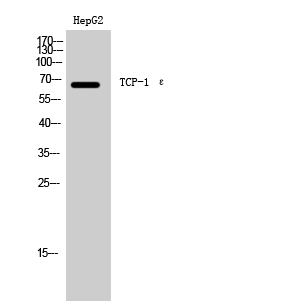TCP-1 ε Polyclonal Antibody
- Catalog No.:YT4584
- Applications:WB;ELISA
- Reactivity:Human;Mouse;Rat
- Target:
- TCP-1 ε
- Gene Name:
- CCT5
- Protein Name:
- T-complex protein 1 subunit epsilon
- Human Gene Id:
- 22948
- Human Swiss Prot No:
- P48643
- Mouse Gene Id:
- 12465
- Mouse Swiss Prot No:
- P80316
- Rat Gene Id:
- 294864
- Rat Swiss Prot No:
- Q68FQ0
- Immunogen:
- The antiserum was produced against synthesized peptide derived from human CCT5. AA range:241-290
- Specificity:
- TCP-1 ε Polyclonal Antibody detects endogenous levels of TCP-1 ε protein.
- Formulation:
- Liquid in PBS containing 50% glycerol, 0.5% BSA and 0.02% sodium azide.
- Source:
- Polyclonal, Rabbit,IgG
- Dilution:
- WB 1:500 - 1:2000. ELISA: 1:10000. Not yet tested in other applications.
- Purification:
- The antibody was affinity-purified from rabbit antiserum by affinity-chromatography using epitope-specific immunogen.
- Concentration:
- 1 mg/ml
- Storage Stability:
- -15°C to -25°C/1 year(Do not lower than -25°C)
- Other Name:
- CCT5;CCTE;KIAA0098;T-complex protein 1 subunit epsilon;TCP-1-epsilon;CCT-epsilon
- Observed Band(KD):
- 67kD
- Background:
- The protein encoded by this gene is a molecular chaperone that is a member of the chaperonin containing TCP1 complex (CCT), also known as the TCP1 ring complex (TRiC). This complex consists of two identical stacked rings, each containing eight different proteins. Unfolded polypeptides enter the central cavity of the complex and are folded in an ATP-dependent manner. The complex folds various proteins, including actin and tubulin. Mutations in this gene cause hereditary sensory and autonomic neuropathy with spastic paraplegia (HSNSP). Alternative splicing results in multiple transcript variants. Related pseudogenes have been identified on chromosomes 5 and 13. [provided by RefSeq, Apr 2015],
- Function:
- disease:Defects in CCT5 are the cause of autosomal recessive sensory neuropathy with spastic paraplegia [MIM:256840]. The disease is characterized by spastic paraplegia and progressive distal sensory neuropathy leading to mutilating ulcerations of the upper and lower limbs.,function:Molecular chaperone; assist the folding of proteins upon ATP hydrolysis. Known to play a role, in vitro, in the folding of actin and tubulin.,similarity:Belongs to the TCP-1 chaperonin family.,subunit:Heterooligomeric complex of about 850 to 900 kDa that forms two stacked rings, 12 to 16 nm in diameter. Interacts with PACRG.,
- Subcellular Location:
- Cytoplasm . Cytoplasm, cytoskeleton, microtubule organizing center, centrosome .
- Expression:
- Bone marrow,Brain,Cajal-Retzius cell,Embryonic kidney,Fetal brain c
- June 19-2018
- WESTERN IMMUNOBLOTTING PROTOCOL
- June 19-2018
- IMMUNOHISTOCHEMISTRY-PARAFFIN PROTOCOL
- June 19-2018
- IMMUNOFLUORESCENCE PROTOCOL
- September 08-2020
- FLOW-CYTOMEYRT-PROTOCOL
- May 20-2022
- Cell-Based ELISA│解您多样本WB检测之困扰
- July 13-2018
- CELL-BASED-ELISA-PROTOCOL-FOR-ACETYL-PROTEIN
- July 13-2018
- CELL-BASED-ELISA-PROTOCOL-FOR-PHOSPHO-PROTEIN
- July 13-2018
- Antibody-FAQs
- Products Images

- Western Blot analysis of HepG2 cells using TCP-1 ε Polyclonal Antibody



